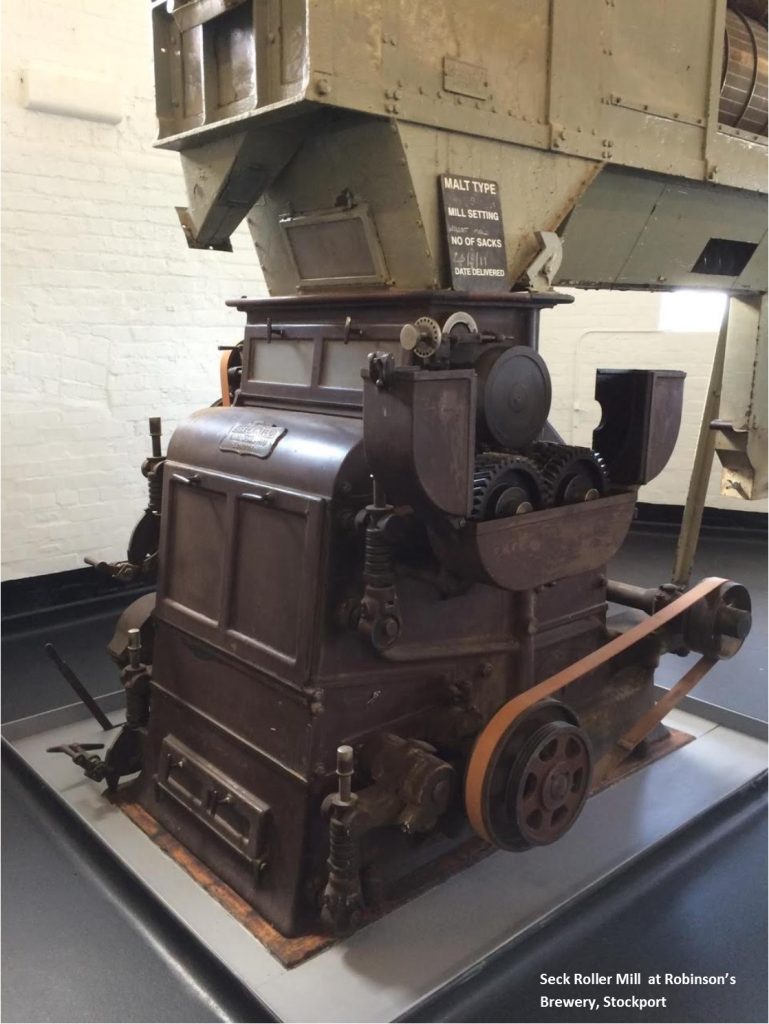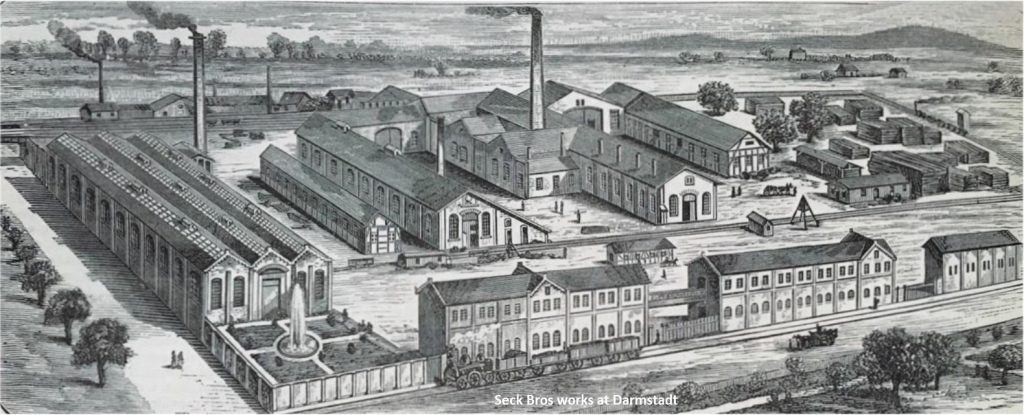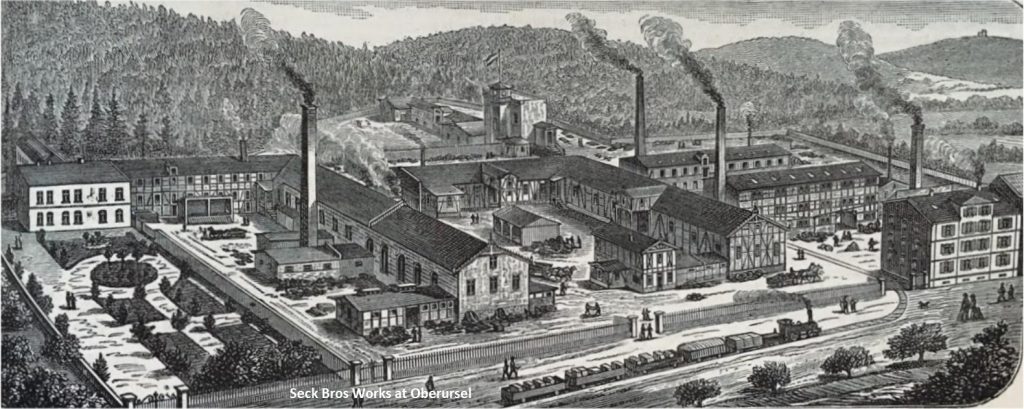Manufacturers: Seck Brothers
What follows is a slightly edited article written by Mildred Cookson, reproduced here with her permission, that was first published in Milling and Grain in August 2016:

The Miller, 7 December, 1885 published a detailed description of this important German firm and I have supplemented this report with material from a newly acquired 1920 catalogue and modern photographs of a Seck mill kindly donated by the Director of the Robinson Brewery in Stockport, where the machine had been in use for at least 83 years up until 2012. The mill remains a showpiece treasure, much admired by visitors to the brewery. Messrs Seck Brothers traded from 41 Seething Lane in London but their works were at Darmstadt and Oberursel in Germany.
Early days
The founder of the firm, milling engineer, Wilhelm Seck, set up his factory in 1865 at Bockenheim near Frankfurt, where he manufactured his successful smutter and decorticating machine. This apparatus, popular both on the continent and in the UK, continued to feature prominently in the Seck range of machines. In 1870 Wilhelm took into partnership his two brothers, Charles and Christian and the new firm flourished. The amazing steps forward in the art and science of milling, after a long, almost dormant, period suddenly brought a demand for new tools, which engineers such as the Secks, could make and supply. The brothers, all originally millwrights, devoted themselves to the production and perfection of these “with rare energy and perseverance”.

Not the least important of their machines was a semolina and middlings purifier, invented by Wilhelm, apparently before the partnership was formed. The Seck “Reform” purifier was immediately successful, especially on the Continent, and was fitted into a great number of German and Austro-Hungarian mills. Henry (Heinrich) Simon, who set up in Manchester as an engineer and developed the first complete automatic mill in England, was allowed to use Seck’s Reform trademark on the “Henry Simon New Reform Purifier”. Although Seck had had teething problems during the initial trials of the Reform, of the 120 ones sold within two years over a hundred were bought by Simon.
In 1874 a branch of the firm was opened in Dresden, but later this was separated from the parent and became a distinct firm run by Charles and Christian, while the old business at Bockenheim was carried on under the direction of Wilhelm alone. Four years later, Wilhelm went into partnership with E. H. Blumenthal, and the works were significantly extended to specialise in casting chilled iron rollers. Even then, the firm was aware of the important part which the roller was about to play in the manufacture of flour and their foresight brought its own rewards. Mr Blumenthal, an important person in the firm, was responsible for orders from the United Kingdom and British Colonies. He regular visited British and Empire millers and could judge their wants and needs.
The Seck system


Seck’s roller system for the gradual reduction of wheat, the outcome of a long and careful series of experiments, was fitted into mills of every capacity, not only in Germany, but also in Belgium, France, England and other countries. To meet the large demand for their rollers the firm moved this branch of the company to Oberursel. As business increased the pressure upon the Bockenheim works became great and it was necessary to find more suitable premises for production. As a result, extensive works were opened at Darmstadt, some fifteen miles from Frankfurt, which would provide the main part of the engineering and millwrighting work of the firm. The Bockenheim workshops were then used exclusively for the manufacture of the recently invented “Perfection” middlings purifier, which had the advantage of rendering a stive room superfluous. The illustrations and ground plan of the works at Darmstadt give some idea of the internal arrangement and organisation of this great factory. The foundry alone had 150 men working in it, and could produce both white and gunmetal. As the company did business all round the world, they employed clerks capable of corresponding fluently in English, French, German, Italian, Spanish and Russian. The firm trained up their own fire brigade from its employees, so that they would be ready for immediate action if required.

The Oberursel works concentrated on the production of the chilled iron rollers used in the company’s roller mills. Motive power for the workshops was provided by two powerful engines and a large waterwheel that could on its own drive the heavy roller cutting and finishing plant. The workforce had almost 1,000 men which included 900 specialist tradesmen. They also employed another 500 workmen in workforces around Europe, engaged in the erection of the many mills which the firm fitted up in the course of each year. Even this number was not enough to keep up with the demand for the company’s machines as they were constantly taking on new employees.
One of the spacious buildings housed the roller mill shop where all kinds of rollers were fitted into their respective frames and finished ready for use. A large space was reserved for the finished roller mills which were ranged in two long rows to allow for careful quality inspection of the finished machines. Moreover, before any machine left the shop each roller mill was tested with two or three day’s actual work on the material it was built to treat.
Early records

The youngest member of the Seck family, Heinrich, started his business in Frankfurt in 1893 then moved to Dresden to take the place of his brother Christian who had died in 1882. It was Heinrich who made the Dresden business into one of the leading companies in Germany and Europe. A rare 1895 photo shows him on the left, just in the photograph. The man in the middle is Wilhelm Seck senior with his son Willy (Wilhelm) on his left.
It is sad that only a few photos and documents from the founding period of the factory at Oberursel exist, partly through a lack of continuity in the company’s history. New owners have unfortunately had the habit of throwing out old company archives! Sadly, some things do not change and this is why I feel it is so important to capture what is left while we can.
